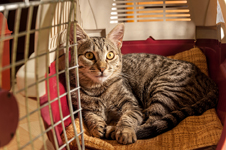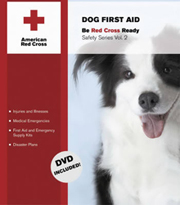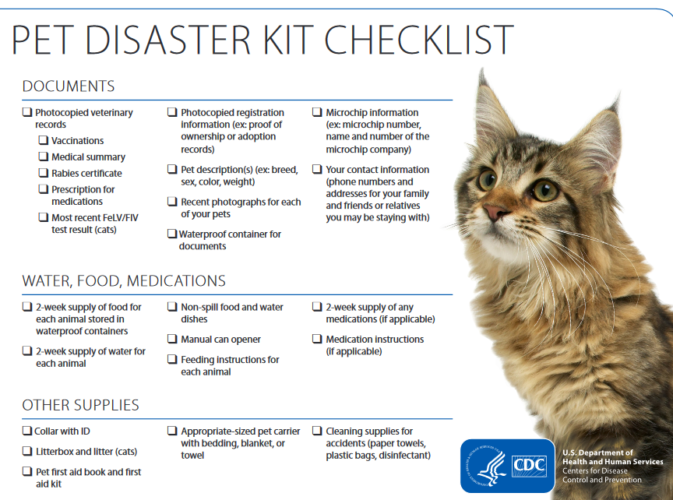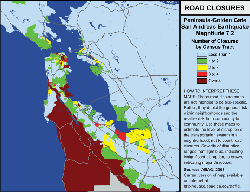PETS earthquake advice from the Humane Society, The Independent Living Resource Center and other sources:
Animals can easily get cut after an earthquake. Ask your vet if there is anything specific you should include for your animal. Consider having the vet ‘microchip’ your pets.
Your pet should wear a securely fastened collar and ID tag. (ID tags and license should be current.)
You need:
current photos of your pets in case they get lost, even if just on your cell phone camera.
(A current picture of you and your pet together can help prove ownership.)
extra pet food/water, bowls, (manual can opener)
cat litter/box,
a 1 month supply of pet’s regular medications,
copies of medical records stored in a water proof container,
sturdy leashes, harnesses, slip-leads and collars

a good pet carrier to transport pets safely and help ensure they will not escape (practice getting them used to it in advance, if the bed in it smells like them they will be more comfortable). A pillowcase can be used for a cat or other small animal if you did not prepare properly. When you have a family evacuation drill, include the pets.
yard tie-out anchor,
blanket for bedding or an easily transportable bed,
a favorite toy,
and you might wish you had a muzzle sized to your dog.
Pets may not be allowed at emergency shelters due to health regulations, etc. (Service animals specifically trained to aid a person with a disability might be allowed). Have proof of current vaccinations. (One local kennel required provide written proof of immunizations (rabies, distemper, parvo, and bordetella) from your veterinarian.)
Keep a list of pet-friendly hotels outside your immediate area in case you have to relocate. If there are none, contact other hotels and ask if they would waive their no pet policies after a disaster, or contact friends and relatives in advance.
DO NOT try to hold your pet during the quake.
Animals will instinctively protect themselves and hide. If you get in the way, even the nicest pets can turn on you. Outdoor pets should be kept inside until the aftershocks have subsided and they have fully calmed down. (And please do remember that the first aftershock can be bigger than the original quake was.)
If you pet is injured, approach slowly and cautiously.
Watch the body expressions and sounds your pet makes to warn you. Even your own pet can be aggressive when in pain or frightened. A cat might crouch with ears flattened to it’s head. A dog might snarl and it’s hair might raise on it’s back/hind. Yes, even your favorite family pet who has slept on your bed.
Quick, jerky movements, or loud voices can scare your pet.
When necessary to treat or move a cat or small dog, use a large towel or blanket to subdue them. You might wish you had tried this in advance to know how your pet might react or even to get your pet used to being handled in this way.
The Red Cross sells pet first aid books and has pet first aid classes.

IF your pet is lost, walk your neighborhood slowly and call out your pet’s name. Inform as many people in the neighborhood as possible so they can keep a lookout. (Have a current picture of your pet to show around. A current picture of you and your pet together, even if you only have one on your cell phone, can help prove ownership.)
If you are looking for your cat after dark, as you make sweeps of shrubbery with your flashlight (electric torch), remember to look for it’s eyes reflecting in the flashlight beam.
Check found animals ads in the paper and run a lost pet advertisement. (During the most recent big quake in our area the cats ran off for days, but came back on their own. The local major newspaper ran the lost pet ad for free.)
Visit the local shelter every day. Make a flyer (before you need it, while there is electricity to use a copier) with pet’s name, description, photo, and your name and phone number.
Consider making your pet a-stay-at-home-inside pet, They are less likely to be injured. In a disaster pets can become disoriented, especially if the disaster has affected scent markers they are used to, to be able to find their way home.
If you have to board your pet, try to visit daily.
You can order a free pet rescue sticker for your front window from www.aspca.org
When an evacuation is needed your pets need to go with you. They might escape from a damaged home and are likely to become victims of exposure, starvation or predators. They might consume contaminated food or water.
AFTER THE QUAKE:
When out for a walk, or even before you let your pet in the yard, be aware of hazards and nose and paw level that weren’t there before. Debris, broken glass, spilled chemicals and fertilizers can be dangerous. Clean them up. Displaced wild animals, including snakes, can be dangerous to your pets. Having pets stay inside for few days could be the best plan.
Be sure any fence you depend on to keep your pet in the yard is still intact.
Watch pets closely. Normally quite and friendly pets may become fearful, aggressive or defensive. If your pet is having persistent behavior problems contact the vet.
You will need a battery-operated air pump (with extra batteries) for the aquarium.
Evacuating with animals takes more time. Preparing in advance will help you evacuate more quickly and give you more options.
If you keep pets inside after the quake, separate cats and dogs. Even dogs and cats that normally get along might act irrationally.

______________________________________________
A family (and babysitters, caregivers, overnight guests) disaster plan is at:
______________________________________________
As a part of preparing for the next earthquake, do a what if? survey of your home, crawl space, attic . .
earthquake home hazards survey
______________________________________________
You can find detailed maps (with zoom in capability) of potential road closures, risk of liquefaction and flooding, such as this map of potential Bay Area road closures after a San Andreas fault 7.2 quake,

at the ABAG link at: Earthquake information sources
Helping Children Cope With Disaster
Store water for after an earthquake
Babysitter Consent and Contact Form
Fast, easy, cheap earthquake preparedness
hazardous household chemical mixtures
The author of this webpage, (written as a homework reading assignment for my students), does not give any warranty, expressed or implied, nor assume any legal liability or responsibility for the accuracy, completeness, or usefulness of any information, product, or process included in this website or at websites linked to or from it. Users of information from this website assume all liability arising from such use.